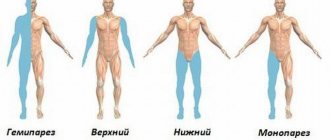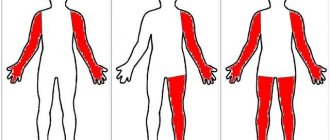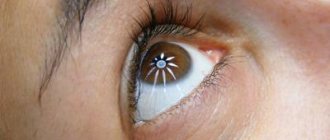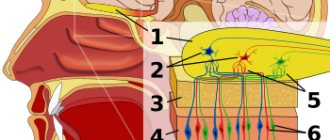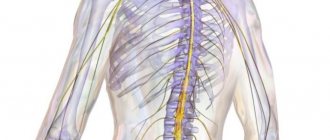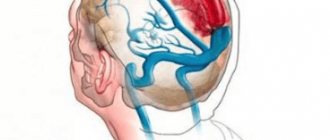What is hemiplegia
Have you been trying to heal your JOINTS for many years?
Head of the Institute for the Treatment of Joints: “You will be amazed at how easy it is to cure your joints by taking the product every day for 147 rubles ...
Read more "
Anatomically, hemiplegia is a partial limitation of the functioning of the nervous regulation of muscle fibers. In this case, doctors talk about pyramidal insufficiency - the impulse from the cells of the cerebral cortex does not fully reach the motor neurons in the anterior horns of the spinal cord. It is for this reason that a person partially loses the ability to voluntarily regulate his movements. The situation is reversible - recovery after appropriate treatment occurs quickly.
Whereas, what is hemiparesis, right-sided or left-sided damage is more severe damage to the nerve fiber. Physiological blockade and even destruction of motor neurons are practically impossible to correct. The muscles gradually completely atrophy and motor activity in the affected part of the body stops.
This is the difference and difference between hemiparesis and hemiplegia - the possibility of recovery. In addition, it is necessary to take into account that in the medulla oblongata the fibers of the pyramidal tract undergo partial decussation. Therefore, visible symptoms of a malfunction in the muscle fibers on the right imply a pathological focus on the left in the cerebral hemispheres. When consulting, specialists, explaining to a person right-sided hemiparesis what it is, point out similar nuances of their disease.
What are hemiparesis and hemiplegia? Differences
Greetings, dear readers and guests of my blog insultu-net.ru, dedicated to neurorehabilitation. Today we will talk about one of the most common and persistent consequences of injuries and diseases of the brain and spinal cord, among which stroke and its consequences are one of its most common causes. Let's talk about hemiparesis and hemiplegia - what they are and what are the reasons for their occurrence. About what needs to be done to restore lost strength and regain movement in the limbs.
Wernicke-Mann gait in hemiparesis and hemiplegia
Hemiparesis is a decrease in muscle strength in half the body , without its complete loss.
Hemiplegia is a complete lack of strength in half the body , that is, paralysis.
Internet Ambulance Medical portal
Write about any bugs you find
Drug rating
Search in the section in answers to questions
Hemiparesis
Found (480 posts)
Hello! My child has moderate left-sided hemiparesis
He is 2.7g, sometimes he pulls his leg, but mostly he has a limp, there is some shortening, I would like to know if there is a need to wear a splint at night? Thanks in advance. open
After an MRI, my 14-year-old son was diagnosed with leukodystrophy of the white matter of the brain. Tell me what to do and how to treat? open
Miloserdov Alek..., the fact is that the child has seizures like epilepsy. He also has a problem with vision and has left-sided hemiparesis
.in a mild form of dsb watch
For 4 months, my daughter had an acute ischemic cerebrovascular accident. At the moment she does not walk, does not talk, her right arm does not work - right-sided hemiparesis
. I would like to know if all this can be treated and for how long. and how best to treat it. open
Occipital lobe. Today the child is 9 months old. does not bark independently, does not sit, does not stand up, also has left-sided hemiparesis
and ptosis of the left upper eyelid. We underwent three rehabilitation courses, massage, exercise therapy, electrophoresis, medications, but there were no obvious improvements. open
There was an operation for meningioma of the right occipital lobe. After the operation, epileptic seizures occurred. There was damage to the optic pathway. Remained once a month blinking... open
Clear, cranial nerves without features. Left-sided hemiparesis
up to 4 points Diagnosis: relapse of meningioma in the parietal region.
in 2011 and 2012 Epilepsy syndrome. Left-sided hemiparesis
Conclusion: tumor removal is indicated Recommendations: preliminary date. look
How old are we, etc. but there are still a lot of problems. To date, one of the diagnoses has been left-sided hemiparesis
. Doctors suggest getting disability. The tone from the left hand did not go away much, we finally began to unclench the fist, but... open
Hello! My daughter (1 year and 4 months) has left-sided hemiparesis
.
On the second day after giving birth, she developed a viral infection. 1st degree). The question is whether hemiparesis
. If yes, then how? Where to go? Doctors. open
Hello! The child is 2 years old. A diagnosis of left-sided hemiparesis was made. Please tell me what this is? How to treat it? Can this be cured? Thanks in advance to open (105 more messages)
Last 5:
Lena, Son is 1.2 years old. right-sided hemiparesis
. I really want to talk to parents who have children with hemiparesis. Where and how who is treated. How do you arrange life for your child? what games and toys do you come up with? If the moderators allow it. Then I’ll drop the link to the group. look
Question to a neurologist. Dear doctor! I am writing to you with the following question: after the stroke, spastic right-sided hemiparesis
. After giving birth, the spasticity in my hand intensified, I am worried about severe pain in my hand, I can’t take medicine - the baby is sucking. open
Suffered a stroke. They were discharged from the hospital with a diagnosis of acute stroke of the type of minor ischemic stroke in the left SMA, motor dysphasia, mild hemiparesis
. dysmetria on the right against the background of stage 1-2 DEP. arterial hypertension 2 tbsp. risk 4. Diabetes mellitus type 2, mild. open
A neurological symptom associated with damage to the motor pathway of impulse propagation to the limbs on one side and manifested by a decrease in muscle strength is called right-sided or left-sided hemiparesis.
Why exactly half of the intestine is removed?
Why, even with a small malignant tumor located far from the midline of the colon, is it customary to remove the entire half of the intestine? Why is it not enough to resect only the area with the tumor?
This is due to several reasons:
- Features of blood supply. The right and left halves of the large intestine are supplied with blood by different branches: the right half - from the superior mesenteric artery, the left half - from the inferior mesenteric artery. When one of the branches is ligated, the entire half of the intestine is cut off from the blood supply.
- The intestinal anastomosis will be most reliable when formed in an area with a mobile part of the colon, covered on all sides by the peritoneum. This area is the transverse colon. And the ascending and descending sections of the large intestine are not completely covered by the peritoneum.
- In case of cancer, maximum removal of regional lymph nodes en bloc with the tumor is necessary. Lymph nodes are located in the mesentery along the blood vessels, as well as in the retroperitoneal tissue.
About the disease
Right-sided hemiparesis is a pathology that is a right-sided lesion of the muscles of the body.
It is characterized by a noticeable decrease in strength and general motor ability of muscles, and incomplete paralysis of the limbs is possible.
This condition manifests itself due to acquired or congenital pathological changes in the pyramidal tracts and the brain.
Doctors observe deviations from the norm when a lesion appears in the left hemisphere of the brain.
This disease leads to the following consequences for the patient:
- Mobility and the patient’s ability to move independently, as well as to care for themselves independently, are reduced when hemiparesis occurs on the dominant side (right-sided hemiparesis in right-handed people);
- The patient experiences inflammatory changes that are associated with prolonged skeletal muscle cramps . This consequence occurs after serious disorders - intracerebral hemorrhages and strokes;
- A problem arises when trying to follow instructions for physical therapy when the patient is undergoing motor recovery due to limited mobility. This happens when there is spastic increased muscle tone.
In children
In children, this pathology occurs as a congenital disease . The reasons for its occurrence are abnormal functionality and structure of the brain , as well as birth injuries. In medical terminology, this disorder is called cerebral palsy - cerebral palsy.
Cerebral palsy appears due to a circulatory disorder in the brain. This pathology affects the fetus while still in the womb and leads to erroneous development and damage to brain structures.
Right spastic hemiparesis
Spastic hemiparesis, often called central, occurs when there is inflammation of the brain or cervical spinal cord.
With this disease, stiffness and muscle tension are observed in the limbs of the opposite side of the body. If individual nerves of the spinal cord are subject to inflammation, then hemiparesis is combined with weakness and decreased muscle tone.
This pathology does not immediately become noticeable; it manifests itself over several months. First, muscle tone increases, which creates tension in the arm and leg, a feeling of stiffness arises, and the ability of the limbs to move decreases. Then, if no treatment is followed, muscle tone continues to increase.
Important! An increase in muscle tone indicates damage to parts of the central nervous system - the brain and spinal cord.
Disturbances in movements that are accompanied by spasticity are seen by others from the outside based on distinctive signs - people have difficulties in gait, it acquires special features. Doctors call it Wernicke-Mann gait . This indicates diseases suffered by the brain - stroke and traumatic brain injury.
Symptoms of right-sided spastic hemiparesis are varied. These include speech disorders, fever, cognitive impairment and seizures similar to epileptic seizures.
Increased muscle tone indicates that the brain and spinal cord are damaged. To reduce tone, the doctor prescribes drugs that relax the muscles. The period of admission is usually long - up to six months, but sometimes longer.
The people were taken aback! Joints will recover in 3 days! Attach...
Few people know, but this is exactly what heals joints in 7 days!
Symptoms
Scientists have discovered a way to treat paralysis
Cerebral palsy has many manifestations. Symptoms of the disease directly depend on the degree of damage to brain structures, as well as on the location of the lesion in a given organ. The progression of cerebral palsy can be noticed after birth, but more often it is detected after a couple of months, when it becomes clearly visible that the newborn is lagging behind in development.
Signs of cerebral palsy in a newborn:
- the baby is not at all interested in toys;
- the newborn does not roll over on his own for a long time and does not hold his head up;
- if you try to stand the baby, he will not stand on his feet, but only on his toes;
- movements of the limbs are chaotic.
Symptoms of cerebral palsy:
- paresis. Usually only half the body, but sometimes they spread to the legs and arms. The affected limbs change - they shorten and become thinner. Typical skeletal deformities in cerebral palsy are scoliosis, sternum deformity;
- violation of the tone of muscle structures. A sick child experiences either spastic tension or complete hypotension. If hypertonicity occurs, then the limbs take an unnatural position for them. With hypotension, the child is weak, tremors are observed, he may often fall, since the muscular structures of the legs do not support his body;
- severe pain syndrome. In cerebral palsy, it develops due to various bone deformations. The pain has a clear localization. It most often occurs in the shoulders, back and neck;
- disruption of the physiological process of swallowing food. This sign of cerebral palsy can be detected immediately after birth. Babies cannot fully suckle from their mother's breast, and infants do not drink from a bottle. This symptom occurs due to paresis of the muscular structures of the pharynx. This also causes drooling;
- speech dysfunction. It occurs due to paresis of the vocal cords, throat, and lips. Sometimes these elements are affected simultaneously;
- convulsive syndrome. Seizures occur at any time and at any age;
- chaotic pathological movements. The child makes sudden movements, may grimace, take certain poses, etc.;
- contractures of articular joints;
- significant or moderate decrease in hearing function;
- developmental delay. This symptom of cerebral palsy does not occur in all sick children;
- decreased visual function. Myopia and strabismus occur more often;
- malfunction of the gastrointestinal tract;
- the patient involuntarily releases excrement and urine;
- progression of endocrine diseases. Children with this diagnosis are often diagnosed with hypothyroidism, dystrophy, growth retardation, and obesity.
A child with cerebral palsy
Main types
The disease can often be found among children as a consequence of cerebral palsy. In general, there are different types of the disease, occurring in both children and adults. Spastic hemiplegia is more likely to appear in pediatric patients. Adults are characterized by contralateral hemiplegia and alternating hemiplegia.
Depending on the type, there are also organic and functional. The organic form is characteristic when blood circulation to the brain is disrupted. It is usually observed with thrombosis, cerebral hemorrhage, and is sometimes observed as a result of inflammatory diseases of the brain.
The organic form develops in connection with disturbances in the functioning of the central nervous system as a result of pathologies. In this case, there is a strong tension in the muscle fibers and tendons in the paralyzed limbs. The disease can be either right or left-sided, but sometimes double hemiplegia occurs, when motor dysfunction is observed on both sides. Sometimes the disease can manifest itself in the form of deterioration in the functioning of the facial muscles.
When the functional form of the disease appears, it is similar to the organic one in only one sign - paralysis of the limbs on one side, the remaining symptoms are completely different. Often this form goes unnoticed.
There is another form of the disease when paralysis occurs crosswise, for example, paralysis of the left arm when a lesion occurs develops on the opposite side. This form is called contralateral, and it is caused by multiple negative effects on the brain.
Alternating hemiplegia is rare and is more common among pediatric patients. Manifests itself spontaneously with random attacks of paralysis of the limbs. This condition can last from a few minutes to several days. With this form, complications such as impaired motor functions of the eyeballs, the occurrence of dystonia, and disruption of the functions responsible for the perception of information are possible.
Diagnostic methods
When considering what hemiplegia is, you will definitely need to familiarize yourself with the methods for diagnosing the disease. Considering the fact that the disease is specific, in most cases there are no problems with establishing the correct diagnosis. In this case, a person in any case will have to undergo a series of examinations to understand what exactly is happening to the body.
The doctor will definitely get acquainted with the medical history to make it easier to establish the cause of the pathology. You will need to collect a life history, which is necessary to identify the possible causes of the formation of a congenital type of the disease. A physical examination and neurological tests will also be performed . It will be necessary to interview relatives and the patient in detail in order to find out when the symptoms of the pathology first appeared.
From laboratory tests, a person is sent for a biochemical and general blood test. If there are deviations in the indicators, you can roughly understand what exactly is happening with your health. You will also need to study cerebrospinal fluid and urine. This will also help you understand what kind of health problems you have.
If we talk about instrumental procedures, the patient is sent to MRI and CT scan of the brain. With their help, it will be possible to understand what form of the disease we are dealing with. You will also need to undergo electromyography or Doppler ultrasound. Based on the results of all the analyses, it will be possible to understand what exactly we are dealing with. When diagnosing spastic hemiplegia, it will be necessary to begin treatment, as in the case of other forms of the disease. In this case, a specific treatment regimen should be prescribed exclusively by a doctor, based on the characteristics of the human body.
Types of hemianopsia
Pathology, depending on which part of the eye blindness occurs, can be divided into several types.
Homonymous. It, in turn, distinguishes the following subspecies:
- right-sided;
- left-handed;
- contralateral;
- square.
Heteronymous. These include:
- bitemporal;
- binasal.
Hemianopsia can also be complete or partial. In the first case, blindness covers the entire area of the visual field, and in the second, a small part of it.
You can find a list of effective eye drops for lenses at this link.
We treat bacterial conjunctivitis in infants - Levomycetin eye drops for newborns.
Homonymous: right-handed and left-handed
With this type of disturbance in the perception of the world, the patient sees only one half of the image field. The line between the part of the picture visible to a person and what is considered a blind spot is located vertically exactly in the center. Pathology can arise either due to disorders in the occipital lobe of the cerebral cortex, or due to damage to the visual pathways.
With contralateral hemianopia, the patient does not see anything that is in the area of the nose of one eye and the temporal part of the other.
Right-sided hemianopsia is presented as a distortion of the perception of the world in the right parts of the left and right eyes. Left-sided - characterized as a visual impairment in which the left side of both eyes is considered the dead zone.
With the square variety, there is loss of the image of only a quarter of the right and left eyes.
The manifestation of hemianopia depends on which side of the brain the affected area is affected.
Preventive therapy – eye drops to improve vision.
Instructions for Dorzopt eye drops are provided at the link.
Treatment tactics
To prevent the formation of complete muscle paralysis - hemiplegia - it is necessary to prescribe treatment and rehabilitation at the initial signs of the disease. Therapy is most effective in the first year of the disease. In a later period, movement disorders are persistent and difficult to correct. A set of therapeutic measures is prescribed depending on the severity of clinical manifestations, age and general condition of the patient.
During the rehabilitation period, the motor ability of the limbs is restored
We advise you to read: Right-sided scoliosis of the thoracic spine
- physiological placement of the limbs using splints to prevent the development of contractures of muscles and joints;
- muscle relaxants to reduce muscle tone and pain caused by spasticity - mydocalm, baclofen;
- drugs to improve blood supply to the brain and normalize the trophism of nervous tissue - Cerebrolysin, Cavinton, Milgamma;
- anticonvulsants – carbamazepine, valproic acid;
- physiotherapy – electrophoresis, ultrasound, diadynamic currents;
- general and segmental body massage, acupressure, reflexology;
- physical therapy (physical therapy) – a set of dosed exercises to normalize the motor activity of affected areas of the body.
Consultations with a psychologist are prescribed, aimed at improving the emotional state and social adaptation of patients. If there is a speech disorder, classes are conducted with a speech therapist. In severe cases, surgery is used on the affected muscles.
After the patient is discharged from the neurological hospital, it is necessary to regularly massage, which relaxes spasming muscles, improves blood flow and metabolism on the affected side of the body. They use relaxing massage techniques using stroking, rubbing, and kneading. To restore the motor ability of the limbs, individual physical therapy exercises are developed in each specific case. Recovery largely depends on the timeliness of treatment and the patient’s strong-willed qualities, on his desire to overcome the disease.
Hemiparesis refers to a serious disease that is accompanied by muscle weakness of one half of the body and other neurological symptoms. The progression of the disease causes the formation of complete paralysis (hemiplegia). With timely treatment, there is a high chance of restoring lost functions, otherwise the pathology leads to disability and loss of self-care skills.


